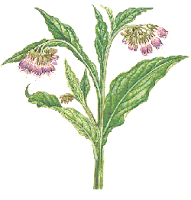Comfrey
Comfrey used to be grown as a medicinal plant. Its pink and blue hanging flowers look like the ones we see on Spanish bluebells. But unlike bluebells, Comfrey grows into a 2-3-foot tall plant with a deep taproot and flowers both spring and fall.
 The ideal place to plant it is as a centerpiece for an herb bed or toward the back of a perennial bed where its large leaves will provide a backdrop for summer flowering plants. Comfrey can grow in full sun or part shade with well-drained soil.
The ideal place to plant it is as a centerpiece for an herb bed or toward the back of a perennial bed where its large leaves will provide a backdrop for summer flowering plants. Comfrey can grow in full sun or part shade with well-drained soil.
There is more than one variety. True Comfrey, Symphytum officinale, is the old fashioned one that was used medicinally for sprains, burns and bruises as well as for ulcers and lung problems. Its medicinal names included knitbone, bruisewort, wonder plant and boneset. Roman and Greek medicine used Comfrey to stop bleeding; medieval herbalists used it to ease arthritis.
The word Comfrey is derived from a Latin word for unite, referring to its use as a bone knitter and the Latin con firma, meaning with strength. It is believed these are references to the plant's ability to heal bones.
Comfrey is no longer recommended for internal use.
True Comfrey is native to England and is grown throughout Europe and Asia. One hybrid, Russian, Quaker Comfrey or Bocking, Symphytum x uplandicum, arrived in Canada in 1954 where it was promoted as an animal food and forage crop (http://tinyurl.com/9uyst35). At one time, Prickly Comfrey was grown as forage by the USDA.
Comfrey plants have no disease or insect problems and bees love the flowers.
Both varieties produce lots of seed that will grow in place if the conditions are right, meaning they can become invasive if they are incorrectly planted in well-fertilized soil.
As the flowers fade, cut back the stems before seed sets if you prefer to have only one or a few plants. Organic gardeners who compost, grow Comfrey to add to their compost pile where the leaves and stems add valuable nutrients pulled from deep in the ground where the taproot grows.
Organic Gardening magazine recommends planting Comfrey around the compost bin where they can benefit from each other. The plants can live up to 20-years with deep taproots.
Gardeners also plant Comfrey as food for rabbits, chickens, pigs and sheep . It is also recommended as a companion plant for fruit trees since it brings pollinators.
“Herbs: The Complete Gardeners Guide” (Patrick Lima, Firefly Books, 2001) recommends making the leaves into a potash-rich manure tea that can be sprayed directly onto plants or used to water.
To plant the seeds, cover lightly with soil and keep them warm and moist. Cool temperatures can help them germinate so there is a benefit to planting them before winter. It can take Comfrey seeds a month or more to sprout so planting them in containers is probably best so you can keep track of them.

If you don't want the plants to spread, cut them back when they make flowers, and mulch the crowns with the leaves. This will keep the seed from dropping, and will improve the soil as well as contribute to the formation of large, healthy plants.
Horizon Herbs (horizonherbs.com) sells True Comfrey seeds 10 for $4 and roots for $5 each, plus shipping. Herb Roots (www.herb-roots.com) sells the roots for $4 each.
Companion Plants (www.companionplants.com) has Yellow Comfrey plants, Symphytum grandiflorum, for zones 5-9. In part-shade they form a ground cover with nodding, cream-yellow flowers. $5 per plant.
Avant Gardens (avantgardens.com) offers variegated Comfrey for dry shade, called Hidcote’s Variegated. The plant grows a foot tall, blue and pink nodding flowers with yellow-green leaves. Zones 5-8. $11 per plant.



Comments